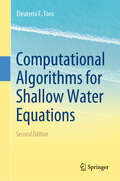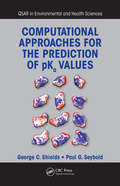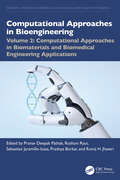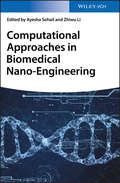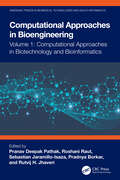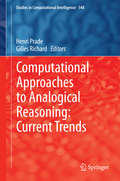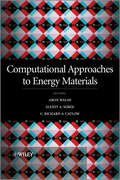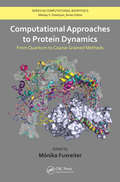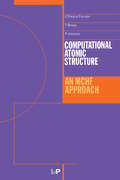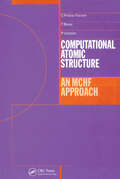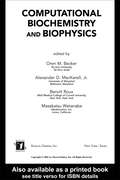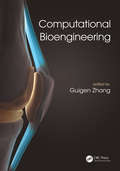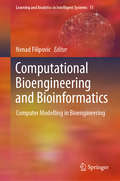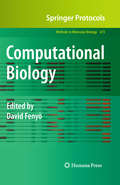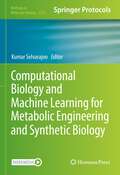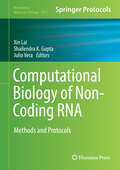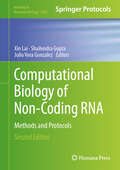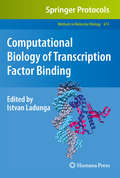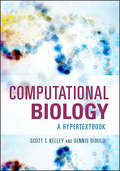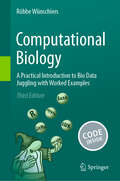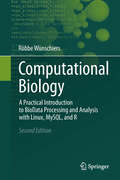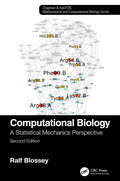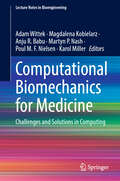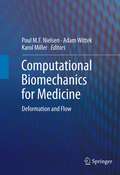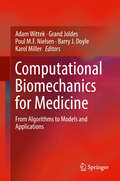- Table View
- List View
Computational Algorithms for Shallow Water Equations
by Eleuterio F. ToroThis book is a thoroughly revised and enlarged version of “Shock-capturing methods for free-surface shallow flows", first published by Wiley and Sons, 2001. The book describes mathematically free-surface flows through partial differential equations and includes modern shock-capturing methods to solve them, with strong emphasis on finite volume upwind and centred methods. Such equations and methods are fundamental in simulating shallow water flows but also atmospheric flows, dispersion of dense gases and the dynamics of mixtures of materials. The book is accompanied by numerical software in the form of sample computer programs as supplementary material. In this new edition, additional sections have been introduced to existing chapters. Also, new chapters have been included; one contains a review of the mathematics of hyperbolic partial differential equations, another introduces the numerical analysis of partial differential equations and another one deals with advanced very-high order numerical methods in the finite volume and discontinuous Galerkin frameworks. Furthermore, comprehensive modifications and corrections have been made throughout various sections of the text, and numerous figures depicting numerical results have been enhanced. This book is primarily intended for environmental scientists, applied mathematicians and engineers in academia, research laboratories, industry and consultancy organisations. Senior undergraduate and postgraduate students involved with mathematical modelling and computational methods for environmental problems will benefit from studying this book. Lecturers could use most of the material for courses on numerical methods for wave propagation problems in hydraulics, oceanography, atmospherics and other geophysical fluid dynamics contexts.
Computational Approaches for the Prediction of pKa Values (QSAR in Environmental and Health Sciences)
by George C. Shields Paul G. SeyboldThe pKa of a compound describes its acidity or basicity and, therefore, is one of its most important properties. Its value determines what form of the compound-positive ion, negative ion, or neutral species-will be present under different circumstances. This is crucial to the action and detection of the compound as a drug, pollutant, or other activ
Computational Approaches in Biomaterials and Biomedical Engineering Applications (Emerging Trends in Biomedical Technologies and Health informatics)
by Sebastián Jaramillo-Isaza Roshani Raut Pranav Deepak Pathak Pradnya Borkar Rutvij H. JhaveriComputational Approaches in Bioengineering, Volume 2—Computational Approaches in Biomaterials and Biomedical Engineering Applications is a comprehensive and up-to-date resource that provides a broad overview of the use of computational methods in the fields of biomaterials and biomedical engineering. Written by a team of experts in the field of biomaterials and biomedical engineering, it provides a wealth of information on the use of computational methods in these fields. Furthermore, it explores emerging trends and discusses future directions and associated limitations in the field. Through thorough exploration and explanation, it showcases the latest research and advancements, offering valuable insights into how computational methods are utilized to design and optimize biomaterials, simulate biological processes, and develop innovative medical devices.FEATURES Provides practical guidance and real-world examples to help readers apply computational approaches effectively in their work Explores the diverse computational approaches employed in biomaterials and biomedical engineering applications, offering a comprehensive view of the field Introduces emerging topics and cutting-edge techniques, keeping wide range of readers at the forefront of advancements in computational bioengineering Discusses the integration of computational methods in biomaterials and biomedical engineering, fostering a deeper understanding of their synergistic potential Provides a valuable resource for researchers, practitioners, and students alike, serving as a comprehensive guide to computational approaches in biomaterials and biomedical engineering applications The book is well-organized and easy to read. The chapters are written in a clear and concise style, and they provide a comprehensive overview of the topics covered. The book is also well-illustrated with figures and tables that help to explain the concepts discussed in the text. With its comprehensive coverage, practical examples, and expert insights, this book serves as a valuable resource for researchers, students, and professionals in the fields of biomaterials and biomedical engineering.
Computational Approaches in Biomedical Nano-Engineering
by Ayesha Sohail Zhiwu LiThis book comprehensively and systematically treats modern understanding of the Nano-Bio-Technology and its therapeutic applications. The contents range from the nanomedicine, imaging, targeted therapeutic applications, experimental results along with modelling approaches. It will provide the readers with fundamentals on computational and modelling aspects of advanced nano-materials and nano-technology specifically in the field of biomedicine, and also provide the readers with inspirations for new development of diagnostic imaging and targeted therapeutic applications.
Computational Approaches in Biotechnology and Bioinformatics (Emerging Trends in Biomedical Technologies and Health informatics)
by Sebastián Jaramillo-Isaza Roshani Raut Pranav Deepak Pathak Pradnya Borkar Rutvij H. JhaveriVolume 1 of Computational Approaches in Bioengineering—Computational Approaches in Biotechnology and Bioinformatics—explores many significant topics of biomedical engineering and bioinformatics in an easily understandable format. It explores recent developments and applications in bioinformatics, biomechanics, artificial intelligence (AI), signal processing, wearable sensors, biomaterials, cell biology, synthetic biology, biostatistics, prosthetics, big data, and algorithms. From applications of biomaterials in advanced drug delivery systems to the role of big data, AI, and machine learning in disease diagnosis and treatment, the book will help readers understand how these technologies are being applied across the areas of biomedical engineering, bioinformatics, and healthcare. The chapters also include case studies on the role of medical robots in surgery and the determination of protein structure using genetic algorithms. The contributors are all leading experts across multiple disciplines and provide chapters that truly represent a complete view of these state-of-the-art technologies.FEATURES Covers a wide range of subjects from biomedical engineering like wearable devices, biomaterials, synthetic biology, phytochemical extraction, and prosthetics Explores AI, machine learning, big data analysis, and algorithms in biomedical engineering and bioinformatics in an easily understandable format Includes case studies on the role of medical robots in surgery and the determination of protein structure using genetic algorithms Discusses genetic diagnosis, classification, and risk prediction in cancer using next-generation sequencing in oncology This book is ideally designed for biomedical professionals, biomedical engineers, healthcare professionals, data engineers, clinicians, physicians, medical students, hospital directors, clinical researchers, and others who work in the field of artificial intelligence, bioinformatics, and computational biology.
Computational Approaches to Analogical Reasoning: Current Trends (Studies in Computational Intelligence #548)
by Henri Prade Gilles RichardAnalogical reasoning is known as a powerful mode for drawing plausible conclusions and solving problems. It has been the topic of a huge number of works by philosophers, anthropologists, linguists, psychologists, and computer scientists. As such, it has been early studied in artificial intelligence, with a particular renewal of interest in the last decade. The present volume provides a structured view of current research trends on computational approaches to analogical reasoning. It starts with an overview of the field, with an extensive bibliography. The 14 collected contributions cover a large scope of issues. First, the use of analogical proportions and analogies is explained and discussed in various natural language processing problems, as well as in automated deduction. Then, different formal frameworks for handling analogies are presented, dealing with case-based reasoning, heuristic-driven theory projection, commonsense reasoning about incomplete rule bases, logical proportions induced by similarity and dissimilarity indicators, and analogical proportions in lattice structures. Lastly, the volume reports case studies and discussions about the use of similarity judgments and the process of analogy making, at work in IQ tests, creativity or other cognitive tasks. This volume gathers fully revised and expanded versions of papers presented at an international workshop, as well as invited contributions. All chapters have benefited of a thorough peer review process.
Computational Approaches to Energy Materials
by Alexey Sokol Aron Walsh Richard CatlowThe development of materials for clean and efficient energy generation and storage is one of the most rapidly developing, multi-disciplinary areas of contemporary science, driven primarily by concerns over global warming, diminishing fossil-fuel reserves, the need for energy security, and increasing consumer demand for portable electronics. Computational methods are now an integral and indispensable part of the materials characterisation and development process. Computational Approaches to Energy Materials presents a detailed survey of current computational techniques for the development and optimization of energy materials, outlining their strengths, limitations, and future applications. The review of techniques includes current methodologies based on electronic structure, interatomic potential and hybrid methods. The methodological components are integrated into a comprehensive survey of applications, addressing the major themes in energy research.Topics covered include: * Introduction to computational methods and approaches* Modelling materials for energy generation applications: solar energy and nuclear energy * Modelling materials for storage applications: batteries and hydrogen* Modelling materials for energy conversion applications: fuel cells, heterogeneous catalysis and solid-state lighting* Nanostructures for energy applicationsThis full colour text is an accessible introduction for newcomers to the field, and a valuable reference source for experienced researchers working on computational techniques and their application to energy materials.
Computational Approaches to Protein Dynamics: From Quantum to Coarse-Grained Methods (Series in Computational Biophysics)
by Mónika FuxreiterThe Latest Developments on the Role of Dynamics in Protein FunctionsComputational Approaches to Protein Dynamics: From Quantum to Coarse-Grained Methods presents modern biomolecular computational techniques that address protein flexibility/dynamics at all levels of theory. An international contingent of leading researchers in chemistry, physics, an
Computational Atomic Structure: An MCHF Approach
by Charlotte Froese-FischerComputational Atomic Structure: An MCHF Approach deals with the field of computational atomic structure, specifically with the multiconfiguration Hartree-Fock (MCHF) approach and the manner in which this approach is used in modern physics. Beginning with an introduction to computational algorithms and procedures for atomic physics, the book describes the theory underlying nonrelativistic atomic structure calculations (making use of Brett-Pauli corrections for relativistic effects) and details how the MCHF atomic structure software package can be used to this end. The book concludes with a treatment of atomic properties, such as energy levels, electron affinities, transition probabilities, specific mass shift, fine structure, hyperfine-structure, and autoionization. This modern, reliable exposition of atomic structure theory proves invaluable to anyone looking to make use of the authors' MCHF atomic structure software package, which is available publicly via the Internet.
Computational Atomic Structure: An MCHF Approach
by Per Jonsson Charlotte Froese-Fischer Tomas BrageComputational Atomic Structure: An MCHF Approach deals with the field of computational atomic structure, specifically with the multiconfiguration Hartree-Fock (MCHF) approach and the manner in which this approach is used in modern physics. Beginning with an introduction to computational algorithms and procedures for atomic physics, the book describes the theory underlying nonrelativistic atomic structure calculations (making use of Brett-Pauli corrections for relativistic effects) and details how the MCHF atomic structure software package can be used to this end. The book concludes with a treatment of atomic properties, such as energy levels, electron affinities, transition probabilities, specific mass shift, fine structure, hyperfine-structure, and autoionization. This modern, reliable exposition of atomic structure theory proves invaluable to anyone looking to make use of the authors' MCHF atomic structure software package, which is available publicly via the Internet.
Computational Biochemistry and Biophysics
by Oren M. Becker, Alexander D. MacKerell, Jr, Benoît Roux & Masakatsu WatanabeCovering theoretical methods and computational techniques in biomolecular research, this book focuses on approaches for the treatment of macromolecules, including proteins, nucleic acids, and bilayer membranes. It uses concepts in free energy calculations, conformational analysis, reaction rates, and transition pathways to calculate and interpret b
Computational Bioengineering
by Guigen ZhangArguably the first book of its kind, Computational Bioengineering explores the power of multidisciplinary computer modeling in bioengineering. Written by experts, the book examines the interplay of multiple governing principles underlying common biomedical devices and problems, bolstered by case studies. It shows you how to take advantage of the la
Computational Bioengineering and Bioinformatics: Computer Modelling in Bioengineering (Learning and Analytics in Intelligent Systems #11)
by Nenad FilipovicThis book explores the latest and most relevant topics in the field of computational bioengineering and bioinformatics, with a particular focus on patient-specific, disease-progression modeling. It covers computational methods for cardiovascular disease prediction, with an emphasis on biomechanics, biomedical decision support systems, data mining, personalized diagnostics, bio-signal processing, protein structure prediction, biomedical image processing, analysis and visualization, and high-performance computing. It also discusses state-of-the-art tools for disease characterization, and recent advances in areas such as biomechanics, cardiovascular engineering, patient-specific modeling, population-based modeling, multiscale modeling, image processing, data mining, biomedical decision-support systems, signal processing, biomaterials and dental biomechanics, tissue and cell engineering, computational chemistry and high-performance computing. As such, it is a valuable resource for researchers, medical and bioengineering students, and medical device and software experts
Computational Biology (Methods in Molecular Biology #673)
by David FenyöComputational biology is an interdisciplinary field that applies mathematical, statistical, and computer science methods to answer biological questions, and its importance has only increased with the introduction of high-throughput techniques such as automatic DNA sequencing, comprehensive expression analysis with microarrays, and proteome analysis with modern mass spectrometry. In Computational Biology, expert practitioners present a broad survey of computational biology methods by focusing on their applications, including primary sequence analysis, protein structure elucidation, transcriptomics and proteomics data analysis, and exploration of protein interaction networks. As a volume in the highly successful Methods in Molecular BiologyTM series, this work provides the kind of detailed description and implementation advice that is crucial for getting optimal results. Authoritative and easy to use, Computational Biology is an ideal guide for all scientists interested in quantitative biology.
Computational Biology and Machine Learning for Metabolic Engineering and Synthetic Biology (Methods in Molecular Biology #2553)
by Kumar SelvarajooThis volume provides protocols for computational, statistical, and machine learning methods that are mainly applied to the study of metabolic engineering, synthetic biology, and disease applications. These techniques support the latest progress in cross-disciplinary research that integrates the different scales of biological complexity. The topics covered in this book are geared toward researchers with a background in engineering, computational analytical, and modeling experience and cover a broad range of topics in computational and machine learning approaches. Written in the highly successful Methods in Molecular Biology series format, chapters include introductions to their respective topics, lists of the necessary materials and reagents, step-by-step, readily reproducible laboratory protocols, and tips on troubleshooting and avoiding known pitfalls.Comprehensive and practical, Computational Biology and Machine Learning for Metabolic Engineering and Synthetic Biology is a valuable resource for any researcher or scientist who wants to learn more about the latest computational methods and how they are applied toward the understanding and prediction of complex biology.
Computational Biology of Non-Coding RNA: Methods and Protocols (Methods in Molecular Biology #1912)
by Julio Vera Xin Lai Shailendra K. GuptaThis volume details a collection of state-of-art methods including identification of novel ncRNAs and their targets, functional annotation and disease association in different biological contexts. Chapters guide readers through an overview of disease-specific ncRNAs, computational methods and workflows for ncRNA discovery, annotation based on high-throughput sequencing data, bioinformatics tools and databases for ncRNA analyses, network-based methods, and kinetic modelling of ncRNA-mediated gene regulation. Written in the highly successful Methods in Molecular Biology series format, chapters include introductions to their respective topics, lists of the necessary materials and reagents, step-by-step, readily reproducible laboratory protocols, and tips on troubleshooting and avoiding known pitfalls. Authoritative and cutting-edge, Computational Biology of Non-Coding RNA: Methods and Protocols aims to provide a state-of-the-art collection of computational methods and approaches that will be of value to researchers interested in ncRNA field.
Computational Biology of Non-Coding RNA: Methods and Protocols (Methods in Molecular Biology #2883)
by Xin Lai Shailendra Gupta Julio Vera GonzalezThis second edition details a collection of state-of-art methods including identification of novel ncRNAs and their targets, functional annotation and disease association in different biological contexts. Chapters guide readers through an overview of disease-specific ncRNAs, computational methods and workflows for ncRNA discovery, annotation based on high-throughput sequencing data, bioinformatics tools and databases for ncRNA analyses, network-based methods, and kinetic modelling of ncRNA-mediated gene regulation. Written in the highly successful Methods in Molecular Biology series format, chapters include introductions to their respective topics, lists of the necessary materials and reagents, step-by-step, readily reproducible laboratory protocols, and tips on troubleshooting and avoiding known pitfalls. Authoritative and cutting-edge, Computational Biology of Non-Coding RNA: Methods and Protocols, Second Edition aims to ensure successful results in the further study of this vital field.
Computational Biology of Transcription Factor Binding (Methods in Molecular Biology #674)
by Istvan LadungaThrough great experimental difficulty, we've witnessed rapid, crucial developments at the intersection of computational biology, experimental technology, and statistics through which the vital process of transcriptional regulation can be further examined. In Computational Biology of Transcription Factor Binding, experts in the field examine the basic principles and provide detailed guidance for the computational analyses and biological interpretations of transcription factor binding, while disclosing critical practical information and caveats that are missing from many research publications. The volume serves not only computational biologists but experimentalists as well, who may want to better understand how to design and execute experiments and to communicate more effectively with computational biologists, computer scientists, and statisticians. Written for the highly successful Methods in Molecular BiologyTM series, this work provides the kind of detailed description and implementation advice that is crucial for getting optimal results in the lab. Authoritative and easy to use, Computational Biology of Transcription Factor Binding guides scientists working in this area and demands not only new experiments but also the re-annotation of existing experimental data and computational predictions leading to important ongoing, major paradigm changes for us all.
Computational Biology: A Hypertextbook (ASM Books)
by Dennis Didulo Scott KelleyAn introduction to the world of bioinformatics Massive increases in computing power and the ability to routinely sequence whole genomes of living organisms have begun to fundamentally alter our understanding of biology, medicine, and agriculture. At the intersection of the growing information and genomics revolutions sits bioinformatics, which uses modern computational power to reveal patterns in biological data sets, especially DNA, RNA, and protein sequences. Computational Biology: A Hypertextbook, by Scott Kelley and Dennis Didulo, provides a wonderful introduction for anyone who wants to learn the basics of bioinformatics. This book is more than a textbook because of the wealth of online ancillary materials and how the print and electronic components are integrated to form a complete educational resource. Aspects that make Computational Biology: A Hypertextbook a unique and valuable tool for teaching and learning bioinformatics include Clear explanations of the basic biology of DNA, RNA, and proteins and how the related bioinformatics algorithms work Extensive exercises that enable students to practice with the same bioinformatics applications that are used by scientists worldwide Tutorials, sample data sets, and interactive learning tools developed with teachers in mind and field-tested by hundreds of students Online tutorials and curated web links that are accurate (instead of frustrating!) and won't lead to dead ends Online resources that work on multiple platforms and electronic devices Computational Biology: A Hypertextbook is written in an accessible voice, punctuated with humor, and designed to significantly increase computational competencies. Biology and computer science undergraduate and graduate students will thoroughly enjoy learning from this unique hypertextbook, as will anyone with an interest in exploring this burgeoning topic.
Computational Biology: A Practical Introduction to Bio Data Juggling with Worked Examples
by Röbbe WünschiersThis extensively expanded third edition offers a practical introduction to Bio Data Science. With a hands-on approach to learning, this book offers ample opportunities to practice: - Installing and utilizing Linux as a virtual machine or remotely - Processing bio data with the programming language AWK - Managing data with the relational database system MariaDB - Analyzing and visualizing data with R - Implementing good bioinformatics practices with Jupyter Notebook and GitHub This book targets both students and professionals in the life sciences. While it is aimed at beginners, it also provides valuable tips and tricks for experienced researchers dealing with large datasets. Worked examples illustrate how to utilize various bioinformatics tools such as BLAST, Clustal, PLINK, IGV, SAMtools, BCFtools, Mason2, Minimap, NCBI Datasets, Velvet, Jmol, and more for: - Identifying bacterial proteins potentially associated with pathogenicity - Querying molecular structures for redox-regulated enzymes - Mapping and assembling real or simulated sequence reads - Identifying and mapping molecular structure mutations in viruses - Conducting genome-wide association studies All software tools and datasets mentioned are freely available, and all code is accessible as Jupyter Notebooks on GitHub. Drawing from the author's experiences and knowledge gained from both academia and industry, this book provides a practical and comprehensive approach to bioinformatics.
Computational Biology: A Practical Introduction to BioData Processing and Analysis with Linux, MySQL, and R
by Röbbe WünschiersThis greatly expanded 2nd edition provides a practical introduction to - data processing with Linux tools and the programming languages AWK and Perl- data management with the relational database system MySQL, and- data analysis and visualization with the statistical computing environment R for students and practitioners in the life sciences. Although written for beginners, experienced researchers in areas involving bioinformatics and computational biology may benefit from numerous tips and tricks that help to process, filter and format large datasets. Learning by doing is the basic concept of this book. Worked examples illustrate how to employ data processing and analysis techniques, e.g. for - finding proteins potentially causing pathogenicity in bacteria, - supporting the significance of BLAST with homology modeling, or- detecting candidate proteins that may be redox-regulated, on the basis of their structure.All the software tools and datasets used are freely available. One section is devoted to explaining setup and maintenance of Linux as an operating system independent virtual machine. The author's experiences and knowledge gained from working and teaching in both academia and industry constitute the foundation for this practical approach.
Computational Biology: A Statistical Mechanics Perspective, Second Edition (Chapman & Hall/CRC Computational Biology Series)
by Ralf BlosseyComputational biology has developed rapidly during the last two decades following the genomic revolution which culminated in the sequencing of the human genome. More than ever it has developed into a field which embraces computational methods from different branches of the exact sciences: pure and applied mathematics, computer science, theoretical physics. This Second Edition provides a solid introduction to the techniques of statistical mechanics for graduate students and researchers in computational biology and biophysics. Material has been reorganized to clarify equilbrium and nonequilibrium aspects of biomolecular systems Content has been expanded, in particular in the treatment of the electrostatic interactions of biomolecules and the application of non-equilibrium statistical mechanics to biomolecules New network-based approaches for the study of proteins are presented. All treated topics are put firmly in the context of the current research literature, allowing the reader to easily follow an individual path into a specific research field. Exercises and Tasks accompany the presentations of the topics with the intention of enabling the readers to test their comprehension of the developed basic concepts.
Computational Biomechanics for Medicine: Challenges and Solutions in Computing (Lecture Notes in Bioengineering)
by Karol Miller Adam Wittek Poul M. F. Nielsen Martyn P. Nash Magdalena Kobielarz Anju R. BabuThis book presents peer-reviewed contributions from the MICCAI 2023 Computational Biomechanics for Medicine CBM XVIII Workshop held in conjunction with the 26th International MICCAI Conference. The content focuses on applications of computational biomechanics to computer-integrated medicine, which includes medical image computing, application of machine learning in image analysis and biomechanics, atlas based biomechanical simulations, novel algorithms of computational biomechanics and experimental methods for analysis of disease and injury mechanisms. The book details state-of-the-art progress in the above fields to researchers, students, and professionals.
Computational Biomechanics for Medicine: Deformation and Flow
by Poul M.F. Nielsen Karol Miller Adam WittekOne of the greatest challenges for mechanical engineers is to extend the success of computational mechanics to fields outside traditional engineering, in particular to biology, biomedical sciences, and medicine. This book is an opportunity for computational biomechanics specialists to present and exchange opinions on the opportunities of applying their techniques to computer-integrated medicine.<P><P> Computational Biomechanics for Medicine: Deformation and Flow collects the papers from the Medical Image Computing and Computer Assisted Intervention conference (MICCAI 2011) dedicated to research in the field of medical image computing and computer assisted medical interventions. The topics covered include: medical image analysis, image-guided surgery, surgical simulation, surgical intervention planning, disease prognosis and diagnostics, injury mechanism analysis, implant and prostheses design, and medical robotics.
Computational Biomechanics for Medicine: From Algorithms to Models and Applications
by Poul M.F. Nielsen Karol Miller Adam Wittek Barry J. Doyle Grand JoldesMathematical modelling and computer simulation have proved tremendously successful in engineering. One of the greatest challenges for mechanists is to extend the success of computational mechanics to fields outside traditional engineering, in particular to biology, biomedical sciences, and medicine. The proposed workshop will provide an opportunity for computational biomechanics specialists to present and exchange opinions on the opportunities of applying their techniques to computer-integrated medicine. For example, continuum mechanics models provide a rational basis for analysing biomedical images by constraining the solution to biologically reasonable motions and processes. Biomechanical modelling can also provide clinically important information about the physical status of the underlying biology, integrating information across molecular, tissue, organ, and organism scales. The main goal of this workshop is to showcase the clinical and scientific utility of computational biomechanics in computer-integrated medicine.
